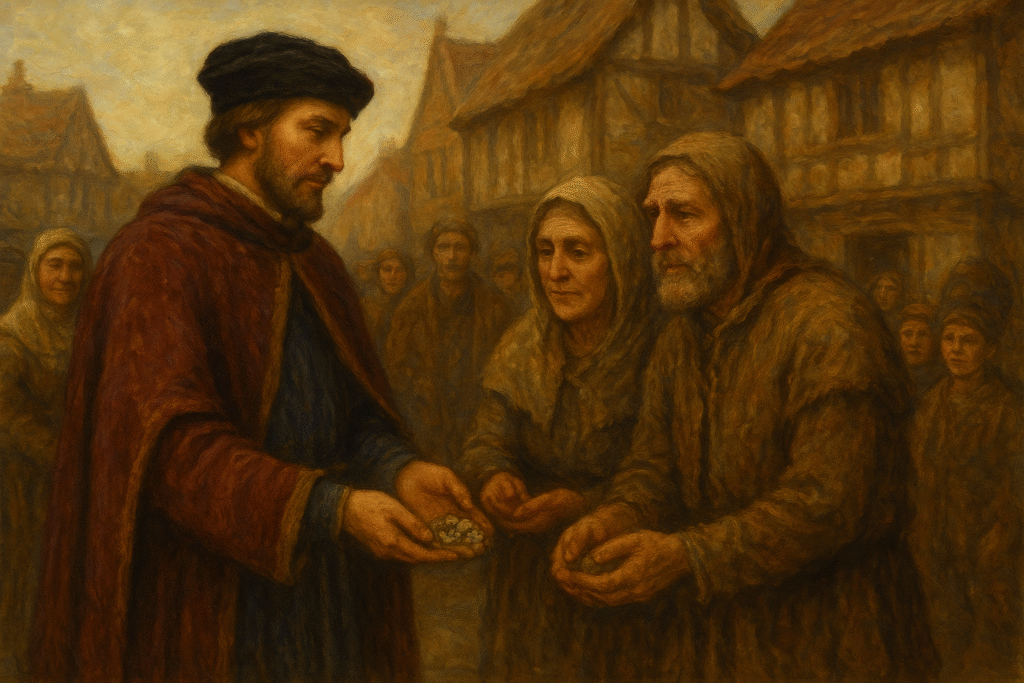The Feast of Buttons
Looking for the Merch?
Grab all of your favorite Memom & The Punk Monkeys gear! From t-shirts to hoodies you'll find all the official gear here.
The Feast of Buttons: A Brackenford Tradition
Origins
The Feast of Buttons traces its roots back to the late 14th century, when famine struck Brackenford and its surrounding villages. Lord Henry Everleigh, a nobleman with a reputation for both eccentricity and compassion, sought to bridge the gap between rich and poor. He announced a great banquet in the Everleigh Hall, declaring that no man, woman, or child would be turned away; all they had to bring was a single button as the price of entry.
The idea was simple: a token so small that even the poorest could afford it, yet symbolic of unity. The wealthy contributed extravagant dishes, wines, and sweets, while the poor brought what they could, often nothing more than a loaf, a jug, or their company. The button itself was collected in great basins at the door, not to be spent but kept as a record of who had come.
From that first night on, Brackenford remembered the “Feast of Buttons” as a day when all ate as equals, and the tradition carried forward for centuries.

The Day of the Feast
The Feast of Buttons is celebrated on the first full moon of November, marking the end of harvest and the beginning of winter’s lean months. The timing reflects its purpose: to remind the town that survival and joy depend on sharing what one has.
At dusk, the church bell tolls seven times, and the feast begins. Long wooden tables are laid in the market square, lit by lanterns and festooned with garlands of dried herbs and woolen ribbons.
Customs & Traditions
The Button Offering: Every participant, rich or poor, drops a button into the great copper basin at the square’s edge. Old families often bring ornate silver or pearl buttons, while children delight in colorful cloth ones. The buttons are later sewn onto a massive communal banner that records each year’s gathering.
The Button Parade: Before the eating begins, children of the town parade through the streets wearing coats covered in buttons collected from past feasts. It’s considered an honor for the “Button Bearer,” the child with the most decorative coat, to lead the procession.
The Table of Equals: Nobles, craftsmen, beggars, and farmers all sit side by side. It’s a matter of pride in Brackenford that no seat is reserved, and the mayor often ends up elbow-to-elbow with the blacksmith’s apprentice.
The Button Cake: A round spiced cake is baked with a single silver button hidden inside. Whoever finds the button in their slice is named “Keeper of the Feast” and is tasked with organizing parts of the next year’s celebration.
The Final Song: At the close of the evening, the townsfolk join in singing the traditional chorus: “Bring your buttons, bring your song, round the table, all belong.” (This is, of course, what inspired the track on the album.)
Symbolism
The button, small and easily overlooked, represents humility and unity. Just as a button binds cloth, the feast binds the people of Brackenford together. Even through centuries of change, plagues, wars, and industrial decline, the Feast of Buttons remained the town’s most cherished holiday.
Modern Revival
Though the practice waned in the early 20th century, the Feast of Buttons has seen a revival in recent decades, reimagined as both a folk festival and a charitable event. Today, townsfolk gather to donate food for the needy, with musicians playing the old tunes (like “Feast of Buttons”) on fiddles, brass, and now electric guitars. Buttons are still collected, now displayed in the town’s small heritage museum.
